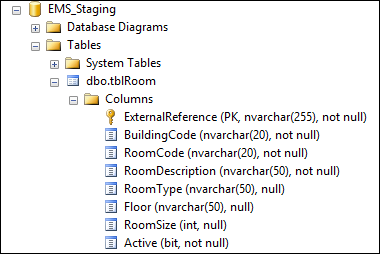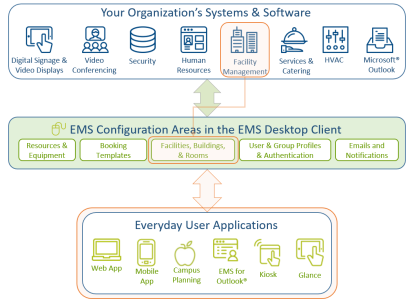What Is Facilities Management Integration?
If your organization uses a Facilities Management (FM) System, facility information may already be maintained there. The EMS FM Toolkit eliminates the need for double entry of facility details and maintenance. Information is automatically updated in EMS to provide the highest level of accuracy and improved communication across departments. This toolkit synchronizes the inventory of space between your facility management systems and EMS to ensure cross-system accuracy. Both EMS and facilities management systems are built upon an inventory of buildings and rooms that forms the basis for meeting and event reservations. The FM Toolkit serves as the connection point between these two systems. The toolkit transfers chosen records to a staging database and updates the appropriate tables in EMS. As with the HR Toolkit, this automates the creation, maintenance, and inactivation of select Building and Room properties from an outside data source.
Integration Diagram
The EMS_Staging Database
The EMS_Staging database (created by FMTK Staging DB Install.sql) is used to stage room records before they are imported into EMS. This is how facilities are mapped between EMS and your HRIS.

Once you have identified the FM data source within your organization that will be used to create and maintain your EMS room records, you will be required to define/create a process to import room records into the tblRoom table within EMS_Staging.
Maintaining Room Records in EMS
The FMTK_Update_Room stored procedure (created by FMTK Update Script.sql) contains all of the logic to create your EMS room data. Records are imported into EMS from the EMS_Staging database according to the specifications outlined in the table below:
|
EMS_Staging.tblRoomField |
EMS.tblRoom Field |
Notes |
|---|---|---|
|
ExternalReference |
ExternalReference |
Required. Primary Key. Unique identifier that links a room record in your FM system with a room record in EMS. |
|
BuildingCode |
BuildingID |
BuildingCode is matched against tblBuilding.BuildingCode to derive the correct Building ID to be stored in tblRoom.BuildingID. If BuildingCode can’t be matched in tblBuilding, the room record WILL NOT be created in EMS. |
|
RoomCode |
Room |
Required |
|
RoomDescription |
Description |
Required |
|
RoomType |
RoomType |
RoomType is matched against tblCategoryGroup.Description (Room Type table) to derive the correct Room Type ID to be stored in tblRoom.RoomType. If the room type can’t be matched in tblCategoryGroup, a new room type record WILL be created. |
|
Floor |
FloorID |
Floor is matched against tblFloor.Description to derive the correct Floor ID to be stored in tblRoom.FloorID. If the floor can’t be matched in tblFloor, a new floor record WILL be created. |
|
RoomSize |
RoomSize |
Optional |
|
Active |
Active |
Active = 1. Inactive = 0. |
The FM Toolkit uses the ExternalReference field in EMS_Staging.tblRoom and the tblRoom.ExternalReference field in the EMS database to determine whether a record needs to be added, updated, or inactivated.
Adding New Records in EMS
- Rooms – If the ExternalReference value in EMS_Staging.tblRoom is not found on an existing room record in EMS, a new room will be created.
Existing EMS clients wanting to implement the FM Toolkit must “synchronize” existing EMS rooms before activating the toolkit by adding a valid ExternalReferencevalue in tblRoom. Ignoring this step will result in duplicate records.
- Room Types – If the RoomType value in EMS_Staging.tblRoom is not found in the existing list of room types in EMS, a new room type will be created.
- Floors – If the Floor value for a particular room record in EMS_Staging.tblRoom is not found in the existing list of floors in EMS, a new floor will be created.
- Buildings – The FM Toolkit does not add or maintain building records in EMS.
Updates to Existing Records in EMS
If the ExternalReference value in EMS_Staging.tblRoom is found on an existing room record in EMS, the room will be updated with any changes.
Inactive Room Records
A room will be inactivated if one of the two conditions outlined below is met:
- If an existing room record in EMS does not exist in EMS_Staging.tblRoom (based on ExternalReference).
- If a room record’s Active status in EMS_Staging.tblRoom = 0.
Room records within EMS with an empty External Reference field are excluded from processing. Therefore, rooms that are not included in your data feed can be added and maintained manually within EMS and will not be impacted by the FM Toolkit.
How Do I Install It?
If you are unsure whether your organization is licensed for the FM Toolkit, or if you would like to learn more about it, contact your Account Executive.
To integrate EMS FM Toolkit:
- Determine the data sources in your organization that will connect facilities management data to EMS.
- Prepare your facilities management data for sharing with EMS.
- Obtain and load the installation components, which are .sql files to establish a database where data will be staged for exchange between EMS and your data source(s).
- Run FM Toolkit to initiate data exchange between EMS and your data source(s).
- Maintain data in your facilities management systems for continual integration with EMS.
How EMS Integrates Your User Records
During the configuration process, you establish an inventory of buildings and rooms in the EMS staging database. Everyday users can then use this inventory of space to book meetings and reservations. Facilities management (FM) systems outside of EMS solutions are also built upon an inventory of buildings and rooms. The FM Toolkit enables organizations to synchronize the space inventory between these two systems.
The FM Toolkit Installation Guide leads you through the steps to install and configure the FM Toolkit in your environment, and explains special considerations for preparing and maintaining your source data.
